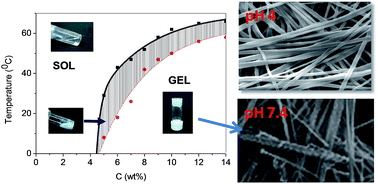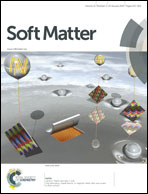Stimuli responsive fibrous hydrogels from hierarchical self-assembly of a triblock copolypeptide
Abstract
In this work, the self-assembly behavior and pH responsiveness of a triblock copolypeptide in aqueous media are demonstrated. The copolypeptide was composed of a central pH responsive poly(L-glutamic acid) (PGA), flanked by two hydrophobic poly(L-alanine) blocks (PAla) (PAla5–PGA11–PAla5). This system showed a pH-responsive transition from short tapes to spherical aggregates by increasing the pH, as a result of deprotonation of the PGA block and a conformational change from α-helix to random coil. Increasing the ionic strength to physiological conditions (0.15 M) has triggered fibrillar self-assembly through intermolecular hydrogen bonding of PAla end-blocks that form β-sheet nanostructures, in conjunction with charge screening of the central random coil PGA segments. At elevated concentrations a thermo-responsive free supporting hydrogel was obtained, consisting of rigid β-sheet based twisted superfibers, resulting from hierarchical self-assembly of the copolypeptide. Yet, morphological transformation of this nanostructure was observed upon switching the pH from physiological conditions to pH 4. An unexpected morphology constituted of α-helix-based giant nanobelts was observed as a consequence of the secondary peptide transitions.


 Please wait while we load your content...
Please wait while we load your content...